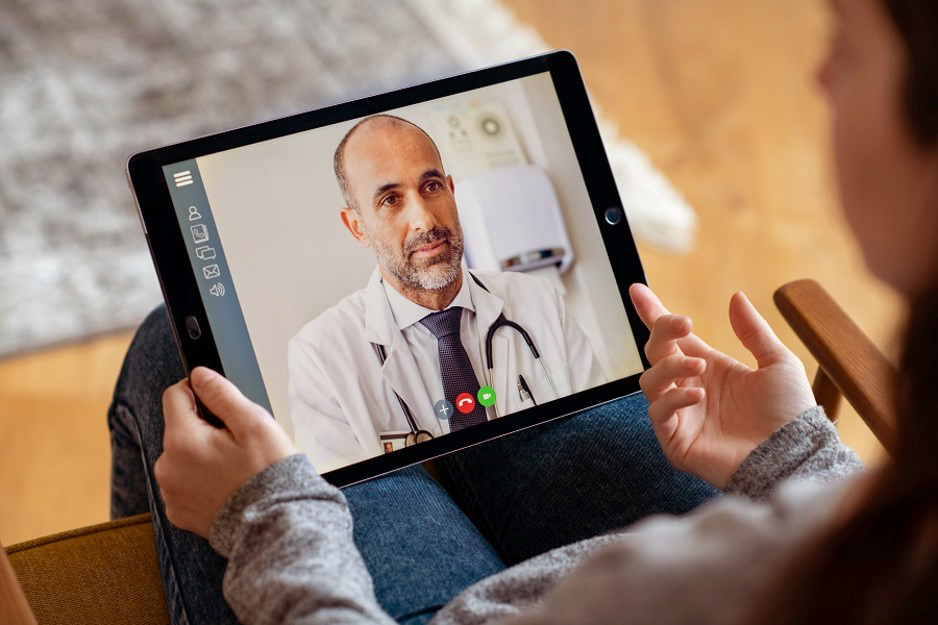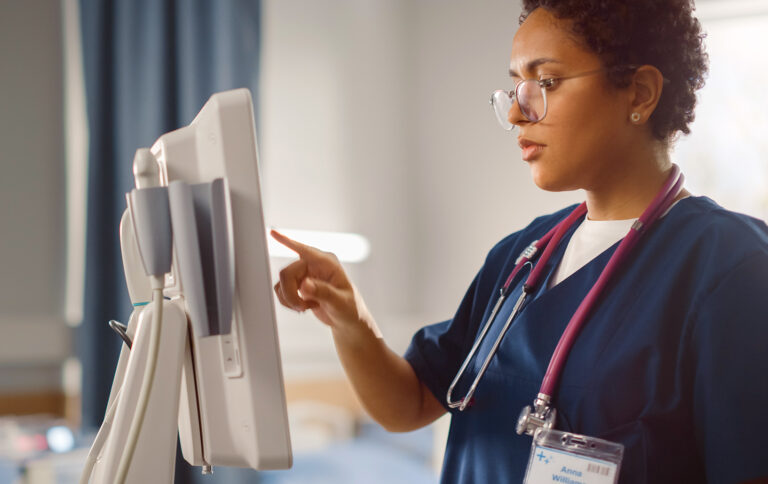SUMMARY
Enovacom’s vision
After long phases of experimentation since the early 2000s, telehealth is now experiencing a major boom, accelerated by the COVID health crisis and the democratization of remote collaboration tools.
Enovacom aims to address the challenges of this new form of remote medicine and care practice, as well as to facilitate access to it for both professionals and patients.
Designing and operating quality telemedicine platforms are based on three pillars.
Our software offering is therefore based on our three areas of expertise:
- practical applications recognized by healthcare professionals reflecting frontline needs;
- the expertise of Enovacom and Xperis ensuring comprehensive interoperability and in-depth integration at the heart of the digital health ecosystem (core government services, computerized patient records, data warehouses, etc.);
- Orange’s guarantee in terms of fiber and mobile network performance, data management and hosting in a cybersecurity environment, which meets all regulatory and sovereignty requirements.
What is telehealth?
Telehealth intends to provide everyone with remote access to medical and paramedical care. It is a form of remote medical practice that uses information and communication technology to connect health professionals with each other and patients.
By definition, telehealth encompasses five main types of telemedicine (teleconsulting, tele-expertise, telemonitoring, tele-assistance and medical regulation), of which three are currently addressed by Enovacom tools.
Tele-expertise
Tele-expertise enables healthcare professionals to remotely call upon one or more medical experts as part of a given healthcare context (e.g., diagnostic reading, analyses, treatment advice). It can be performed synchronously or asynchronously and requires sharing the key elements of the patient record.
Enovacom’s platform adapts to any type of tele-expertise, regardless of the specialty concerned. It also boasts extensive experience in some highly specialized practices, such as:
Teleradiology and tele-imaging
Teleradiology is a component of telemedicine that encompasses the performance of radiological activities using remote communication technology. It is a major means for improving access to radiology services, especially in areas lacking specialists.
This service enables radiologists to receive and interpret medical images remotely, providing their diagnostic expertise no matter where they are. Thanks to IT breakthroughs, teleradiology meets all safety and confidentiality standards, thereby complying with telemedecine requirements.
Teleradiology platforms include state-of-the-art tools for the secure transmission of medical images, access to remote X-ray workstations, and integration capabilities with hospital information systems (HIS). Radiologists benefit from a virtualized work environment that enables them to analyze diagnostic data and generate detailed reports from the radiology information system (RIS), which are then sent to the requesting healthcare facility.
Teleradiology incorporates into the broader telemedicine framework, transforming the delivery of health services by expanding the scope of radiological skills and ensuring seamless and connected treatment of patients, regardless of where they live, representing a major evolution in modern medical practice.
Emergencies and teleregulation
Initially performed only by telephone, teleregulation has been enriched with a number of digital tools to add digitized assessments, imaging, and complementary exams like electrocardiogram reading performed by field personnel.
Its major benefits include optimized initial assessments, faster decision-making and patient referral to the service most suited to their pathology. Avoidable hospitalizations are also an important upside, especially with current overcrowding across emergency departments nationwide.
Furthermore, the widespread use of teleregulation over the past few years has made it possible to establish a video call directly with those contacting emergency services (patient or field personnel) through a link sent to their smartphone. This enables to better assess the seriousness of the situation. (wound, respiratory discomfort, state of consciousness, circumstances of an accident, etc.)
Telehealth for which emergency responders?
Field personnel (paramedics, fire fighters, first-aid respondents, mobile emergency and resuscitation infrastructure, etc.) benefit from the complete digitization of their response records. Beyond simply digitizing the paper records, this allows for better data traceability, simplified archiving and optimized operation. The sharing and real-time view of the entire response data right from the emergency department’s medical regulation process is now a core element based on the historical experience of Enovacom’s Nomadeec platform, which has been paving the way since 2016.
Health institutions and professionals other than those involved in pre-hospital emergency care can use Enovacom’s Nomadeec solution. However, they can only do so as part of the emergency response to share patient data with the emergency department’s regulation service.
This is already the case for many social medicine institutions (retirement homes, nursing homes, specialized foster homes) as well as home hospitalization services, penitentiary institutions, amusement parks, etc.
Our emergency telemedicine platform can bring together all emergency telemedicine tools across a territory. Whether for a call center or a regulatory center, it enables emergency care stakeholders to communicate easily to better support patients.
Teleassistance
Tele-assistance enables health care professionals to remotely assist colleagues as they perform a technical procedure or deliver care.
Performed as part of synchronous videoconferencing, it ideally requires sharing the requestor’s view through specialized devices (body camera or augmented reality helmet). Our teams have developed several experimental use cases and they remain available to study new projects.
In addition to the fully mastered technical aspects, practical guidance for these projects remain critical to building the solution adapted to the type of procedure addressed through tele-assistance, in order to guarantee its use and medical benefit for patients.
Telecare
Telecare enables a physician’s assistant or pharmacist to manage patients and monitor them remotely using information and communication technology.
Again, our telemedicine solutions address all of these new uses (chronic wound monitoring, remote kinesiotherapy or speech therapy, therapeutic counselling by a pharmacist, or certain specialized nursing advice).
Teleconsultation
Teleconsultation consists in a remote consultation between a medical professional (physician, midwife or dental surgeon) and a patient using information and communication technology.
This process, completed through a videoconference, can involve the patient alone or accompanied by a health professional. The latter is called assisted teleconsultation. The complementary use of connected medical devices (tensiometer, oximeter, electrocardiogram, digital stethoscope, etc.) can help inform the decision by enabling a comprehensive off-site clinical exam.
Sharing elements of the patient’s record is a core part of this process and is facilitated by our interoperability expertise, particularly through our interoperability platform and appointment scheduling.
While telemedicine does not apply to every situation, it does offer a new, undeniably beneficial alternative to many issues patients face on a daily basis, such as remote populations (rural areas, aging population), lack of medical care in the area, long wait times to get an appointment with a specialist, time-consuming travel, and chronic disease monitoring.
Born of the merger of two historic platforms (Nomadeec and Nexus) that blazed trails in the field of inpatient and outpatient telemedicine, Enovacom’s platform helps cover all scheduled and unscheduled teleconsultation scenarios pertaining to first-aid medicine or specialized advice.

Interoperability benefitting telehealth

The interoperability capability of telemedicine platforms is a key success factor for project deployment and sustainable day-to-day use. Indeed, the telemedicine tool must be integrated into the requesting healthcare professionals’ workflow.
The objective first consists in aggregating patient context data, then populating computerized patient records at the end of any intervention.
- Specifically, this includes the ability to interconnect with:
- hospital, pre-hospital or regulation patient record software;
- prescription software;
- appointment management platforms and other digital tools used by healthcare professionals;
- specialty software.
- An interoperable telemedicine platform like Enovacom’s improves the efficiency of care by avoiding redundancies and errors, facilitating access to health information and ultimately enabling more informed decision-making.
- It also contributes to health research and innovation by collecting qualified and structured data that feeds into warehouses of valuable health data for the analysis and improvement of medical practices or epidemiology, for example.



